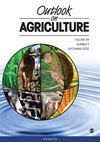Editorial: Why agroecology?
IF 2.6
3区 经济学
Q1 AGRICULTURE, MULTIDISCIPLINARY
引用次数: 0
Abstract
During the past 10–15 years, agroecology has grown in prominence in global agricultural discourse based on a belief that it can dramatically transform agrifood systems (Anderson et al., 2021). The concern of proponents of agroecology – that modern agriculture, often referred to as conventional or industrial, has been principally responsible for agroecosystem degradation – has led to calls for agroecology to replace conventional agriculture. As Sumberg and Giller (2022) have observed, the term conventional agriculture has been weaponised. No doubt, overuse of agrochemicals and mono-cropping has led to environmental problems such as pollution, soil erosion and in some circumstances, loss of wild biodiversity. These problems need to be addressed. Yet, paradoxically, the main focus of agroecology promotion is smallholder farmers in less-developed countries where conventional or industrial agriculture is not a common form of farming. Furthermore, this discourse mainly pursues a questionable binary agenda: agroecology versus conventional agriculture. It ignores the fact that hundreds of millions of farmers already deploy a range of good agricultural practices considered to be agroecological. These include crop rotation, intercropping, mixed crop-livestock systems, manure recycling, and integrated pest management, among others, together with conventional technologies such as improved crop varieties, judicious use of agrochemicals and functional biodiversity. For example, mixed crop-livestock systems, considered agroecological even when many deploy conventional technologies, produce around 50% of the world’s food (Herrero et al., 2010). In the past 60 years, food production systems have realized impressive achievements based on sound science, technology and innovations (Evans, 1998; OECD, 2021). As world population more than doubled, global food production has almost quadrupled whilst using only 10%– 15% more agricultural land. This has been achieved through large production increases per unit area of land. Much of global farming responsible for adequately feeding over 7 billion people is based on improved crop varieties and appropriate use of agrochemicals integrated with agroecological approaches. Crucially, the promotion of agroecology should not only be based on environmental and equity issues but also on its ability to continue to ensure food and nutritional security and provide livelihoods for farmers. Although the term agroecology first appeared around a century ago, its meaning has evolved and broadened in the interim period. Wezel and Soldat (2009) provide a useful historical account of the evolution of the term. From the 1930s to the 1960s, agroecology was firmly anchored in the science of crop production and protection. However, from the 1960s onwards, environmental activists motivated agroecological movements and agroecology evolved into a broad mixture of science, practices and movements with different groups and nations placing varying emphases on the three main components. As a consequence, there are many different definitions of agroecology and no internationally approved terminology. The Biovision Agroecology Info Pool lists 23 different definitions of agroecology from the research community, United Nations (UN) agencies, public organizations and civil society. Generally, the research community gives more emphasis to agroecology as a scientific discipline and a practice while civil society and UN agencies tend to emphasize agroecology as a social movement. There are also additional definitions in books and peer-reviewed journal articles on the topic. I find the definition by Martin and Sauerborn (2013): ‘an interdisciplinary approach to the relevant aspects of agricultural production related to the interactions between natural processes, human activities and the environment’ most useful. It includes three core components: agriculture, the environment and people. In general, scientific research on agroecology is mainly carried out in developed regions, especially in Europe, while promotion through active social mobilization tends to be concentrated in less-developed countries, significantly in Latin America and, increasingly, in subSaharan Africa. Furthermore, as Wezel (2017) stated ‘there is no definitive set of practices that can be labelled as agroecological, nor clear, consensual boundaries between what is agroecological and what is not’. The lack of a defined threshold is a recipe for confusion. For example, is a smallholder farmer who grows improved, disease resistant and drought-tolerant varieties of a cereal and a legume in an intercropping system using both farmproduced compost as well as fertilizers considered agroecological or not? The statement by Altieri et al. (2017 that ‘A true agroecological technological conversion calls into question monoculture and the dependency on external inputs’ creates further doubt. In spite of agroecology beginning its life as a scientific discipline and being strongly based on the ecology of agroecosystems for 60 years, the science, and especially the ecology part of agroecology, appears to have been marginalized. Definitions can change over time but the significant broadening of the term agroecology and the surge in the number of different definitions are leading to growing questions around what agroecology actually is. When the common Editorial社论:为什么是农业生态学?
在过去的10-15年里,农业生态学在全球农业话语中越来越突出,因为人们相信它可以极大地改变农业食品系统(Anderson等人,2021)。农业生态学支持者的担忧——现代农业,通常被称为传统农业或工业农业,是农业生态系统退化的主要原因——导致了人们呼吁农业生态学取代传统农业。正如Sumberg和Giller(2022)所观察到的,“传统农业”一词已被武器化。毫无疑问,过度使用农用化学品和单一种植导致了环境问题,如污染、土壤侵蚀,在某些情况下,还导致了野生生物多样性的丧失。这些问题需要解决。然而,矛盾的是,促进农业生态的主要重点是欠发达国家的小农户,在这些国家,传统或工业农业不是一种常见的农业形式。此外,这篇文章主要追求一个有问题的二元议程:农业生态学与传统农业。它忽略了一个事实,即数亿农民已经采用了一系列被认为是农业生态的良好农业做法。其中包括轮作、间作、混合作物畜牧系统、肥料回收和病虫害综合管理等,以及改良作物品种、明智使用农用化学品和功能性生物多样性等传统技术。例如,即使许多人采用传统技术,混合作物畜牧系统也被认为是农业生态系统,生产的粮食约占世界粮食的50%(Herrero等人,2010年)。在过去的60年里,粮食生产系统在健全的科学、技术和创新的基础上取得了令人印象深刻的成就(Evans,1998;经合组织,2021)。随着世界人口增加了一倍多,全球粮食产量几乎翻了两番,而农业用地只增加了10%-15%。这是通过大幅提高单位土地面积的产量来实现的。负责为70多亿人提供充足食物的全球农业,很大程度上是基于改良作物品种和适当使用农用化学品以及农业生态方法。至关重要的是,促进农业生态不仅应基于环境和公平问题,还应基于其继续确保粮食和营养安全以及为农民提供生计的能力。尽管农业生态学一词最早出现在大约一个世纪前,但其含义在这一过渡时期有所演变和扩大。Wezel和Soldat(2009)对该术语的演变提供了有用的历史描述。从20世纪30年代到60年代,农业生态学牢牢地植根于作物生产和保护科学。然而,从20世纪60年代起,环境活动家推动了农业生态学运动,农业生态学演变成了科学、实践和运动的广泛混合体,不同的群体和国家对这三个主要组成部分给予了不同的重视。因此,农业生态学有许多不同的定义,没有国际认可的术语。Biovision农业生态学信息库列出了来自研究界、联合国机构、公共组织和民间社会的23种不同的农业生态学定义。一般来说,研究界更重视农业生态学作为一门科学学科和实践,而民间社会和联合国机构则倾向于强调农业生态学是一场社会运动。关于这个主题的书籍和同行评审期刊文章中也有其他定义。我发现Martin和Sauerborn(2013)的定义:“对与自然过程、人类活动和环境之间的相互作用有关的农业生产的相关方面采取跨学科的方法”最有用。它包括三个核心组成部分:农业、环境和人。总的来说,农业生态学的科学研究主要在发达地区进行,特别是在欧洲,而通过积极的社会动员进行的推广往往集中在欠发达国家,尤其是拉丁美洲,而且越来越多地集中在撒哈拉以南非洲。此外,正如Wezel(2017)所说,“没有一套明确的做法可以被称为农业生态学,也没有明确的、一致同意的农业生态学和非农业生态学之间的界限”。缺乏明确的阈值会造成混乱。例如,一个小农户在间作系统中种植改良的、抗病的和耐旱的谷物和豆类品种,使用农场生产的堆肥和肥料,是否被认为是农业生态的?Altieri等人(2017年)的声明称,“真正的农业生态技术转换对单一种植和对外部投入的依赖提出了质疑”,这进一步引起了人们的怀疑。 尽管农业生态学最初是一门科学学科,60年来一直以农业生态系统生态学为基础,但这门科学,尤其是农业生态学的生态学部分,似乎已经被边缘化了。定义可能会随着时间的推移而变化,但农业生态学一词的显著扩展和不同定义数量的激增,导致人们对农业生态学到底是什么产生了越来越多的疑问
本文章由计算机程序翻译,如有差异,请以英文原文为准。
求助全文
约1分钟内获得全文
求助全文
来源期刊

Outlook on Agriculture
农林科学-农业综合
CiteScore
5.60
自引率
13.30%
发文量
38
审稿时长
>36 weeks
期刊介绍:
Outlook on Agriculture is a peer reviewed journal, published quarterly, which welcomes original research papers, research notes, invited reviews and commentary for an international and interdisciplinary readership. Special attention is paid to agricultural policy, international trade in the agricultural sector, strategic developments in food production, the links between agricultural systems and food security, the role of agriculture in social and economic development, agriculture in developing countries and environmental issues, including natural resources for agriculture and climate impacts.
 求助内容:
求助内容: 应助结果提醒方式:
应助结果提醒方式:


